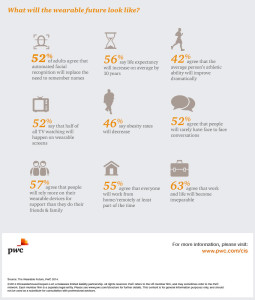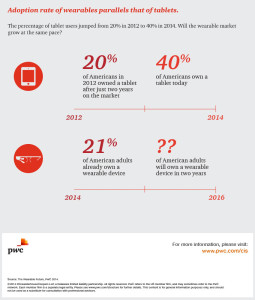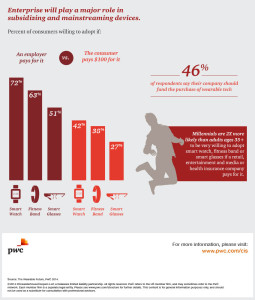 “A wearable future is around the corner,” PwC says. So it’s appropriate the consulting firm’s new report is indeed titled The Wearable Future.
“A wearable future is around the corner,” PwC says. So it’s appropriate the consulting firm’s new report is indeed titled The Wearable Future.
Wearable technologies — smartwatches, sensor-laden workout gear, activity tracking wristbands, and Google Glass, among them — are more than individual tracking and information devices. They’re part of a larger ecosystem called The Internet of Things (IoT), which is made of lots of stuff, each ‘thing’ incorporating a sensor that measures something. Those measurements can track virtually everything that someone does throughout the day: beyond the obvious steps taken, hours slept, and GPS coordinates, sensors can sense movement in terms of balance and gait, temperature, light and dark, mood, and countless parameters which taken together, mashed up and analyzed, can inform a person in a variety of ways.
PwC’s research finds that most people are open to living in a sensor-laden world, especially if the devices’ costs are subsidized by someone else (namely, employers), and if the output is useful (read: yields value to the individual). PwC calls out the importance of user-centered design, so that things-with-sensors don’t get disbanded within weeks of adoption — as many activity trackers get tossed into drawers for time immemorial.
 PwC compares the current state of wearable tech adoption among consumers with that of the first wave of tablet use: 21% of U.S. adults use some form of wearable device in 2014, the same percent of tablet penetration in 2012. Today, tablets are used by 40% of people in the U.S. Will wearables have the same market demand trajectory?
PwC compares the current state of wearable tech adoption among consumers with that of the first wave of tablet use: 21% of U.S. adults use some form of wearable device in 2014, the same percent of tablet penetration in 2012. Today, tablets are used by 40% of people in the U.S. Will wearables have the same market demand trajectory?
“Wearables already have a strong incumbent challenger — the smartphone,” PwC writes. The smartphone is in fact both a barrier and opportunity in the world of wearables. The phone is essentially a wearable – after all, people not only adopt cell phones, we marry them, B.J. Fogg wrote in the seminal book, Texting 4 Health, in the early days of mobile tech.
In health, PwC found that:
- 80% of people believe that wearable tech can make health care more convenient
- 2 in 3 people would use a wearable tech if their employers subsidized their cost and discounted their health insurance premium
- Consumers would trust a wearables recommendation from their doctor versus advice from any other source
- 46% of people believe obesity rates will fall as a result of using wearable tech
- 42% agree people’s athletic abilities will dramatically improve
- Most people think life expectancy will increase by, on average, 10 years due to using wearable tech.
There’s a Mars/Venus difference between how men perceive wearables versus women’s perspective. Men tend to view wearable tech for enabling gaming, and women are more into fitness and contests when talking wearables on social media.
For wearables, beyond the cost/price issue, consumers are most concerned about privacy and security related to data protection. If an organization subsidizes the cost of a wearable, consumers are less likely to be concerned about privacy — signalling the value/privacy trade-off that consumers are beginning to make as their interactions with mobile platforms and social networks mature. But PwC smartly recommends that manufacturers of wearable and companies that may use them should “repeatedly” test, navigate and respect their use, and the data generated by these devices.
I commend PwC’s multi-pronged methodology used for this study: the firm conducted expert interviews, mined consumer survey data on brands and attitudes, and scraped insights from about 6 million social media conversations online. This approach yielded a colorful, rich story and data that will be useful for those of us working in media, retail, healthcare, and consumer goods.
Health Populi’s Hot Points: “In a market that is saturated with technology for innovation’s sake, we don’t need more innovation — we need more meaningful applications,” PwC concludes. Today, consumers feel ambivalent about wearables, the research shows; Millenials and under-35s are more excited about the issue. But there is more optimism for the future, as most consumers can envision the value of passively collecting personal data and getting activated by it through information and nudges. Simply put, for health, it’s about behavior change for mass self-improvement, not about a shiny new thing and data collection.
To that point, Douglas Atkin of AirBnB told PwC researchers, “In the distant future, we’ll forget the idea of engaging in technology at all. We’ll sallow it, absorb it, and wear it, without us really thinking we’re engaging in technology per se.”
An a-ha moment for me in the data is that a bulk of American consumers is looking to employers to subsidize/pay for wearable technologies to provide at the workplace, and to use as a lever for lowering health premiums.
At the same time, consumers seem unaware that most employers are evaluating their role in providing health insurance benefits at the workplace in a version 1.0 traditional role of employee benefits. In fact, the U.S. health benefits market is fast-moving from defined benefit to defined contribution, where it’s more of a DIY offering where workers are being allocated more responsibility for decision making in both clinical and financial health realms.
How does the expectation/wish of a worker looking to an employer to pay for wearable tech square in a world of defined contribution? If employers increasingly couple consumer-directed health plans with wellness programs, wearables may play a role, especially in those workplaces where companies have a mindset or corporate culture of wellness and productivity company-wide. But this probably won’t be the norm for most U.S. workers, who will have to figure out if and how much to shell out of take-home pay for wearable tech — especially that related to health and health care.
There’s also very little mention of the health “care” system drawn in the report’s page-and-a-half on health industry implications. The linch-pin here is the physician, who today is implementing an electronic health record that cannot absorb the sensors’ information generated by devices manufacturing by Fitbit, Jawbone, Withings, and other recognized brands in the fitness/wellness space. Nor is there evidence that most primary care physicians, already stretched and under-supplied, wish to grapple with more data. It’s quite easy to generate health-related data and observations of daily living that impact health: much harder to do the sense-making from sensor-driven data, as I discussed in my report from California HealthCare Foundation, Making Sense out of Sensors in Healthcare in February 2013.
PwC offered this video on the report, for your viewing pleasure…
P





 Thanks to Feedspot for naming this blog, Health Populi, as a
Thanks to Feedspot for naming this blog, Health Populi, as a